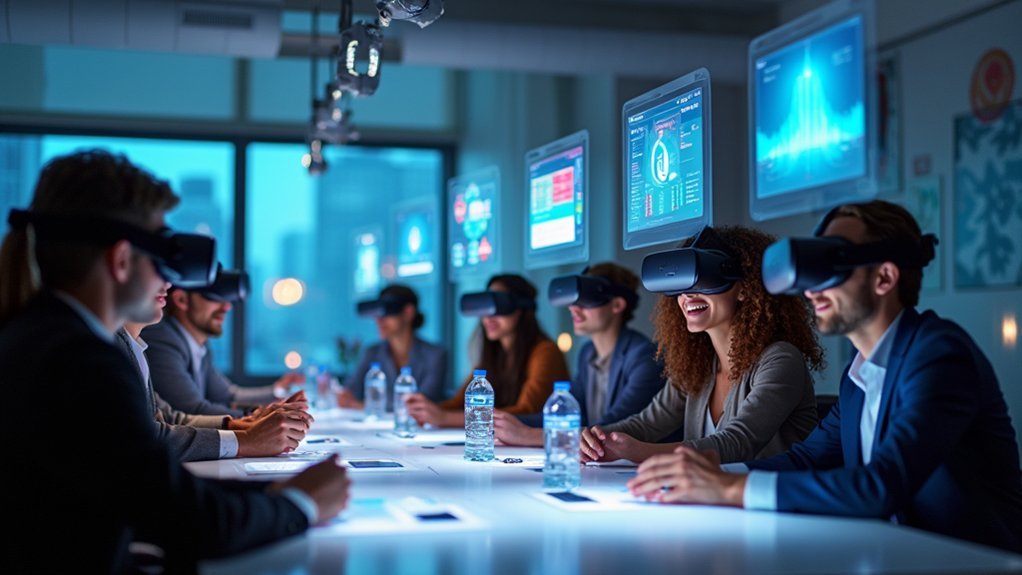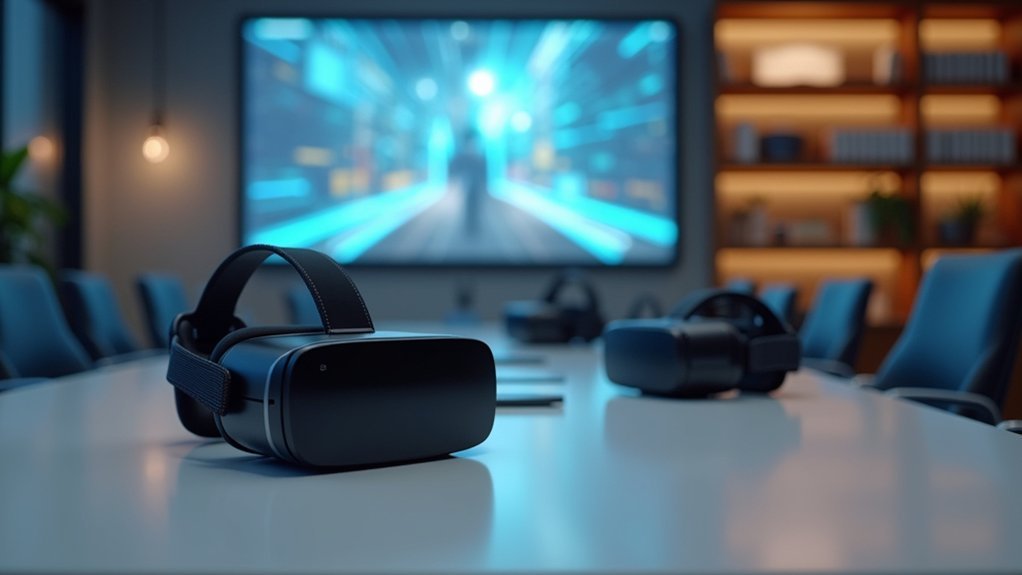Today’s top enterprise headsets for workplace training include Meta Quest Pro with superior processing power, Pico 4 Enterprise offering customizable settings at a lower price point, and Apple Vision Pro for seamless integration with Apple ecosystems. You’ll achieve up to four times faster training completion rates and 31% higher employee retention with these immersive solutions. The right headset choice depends on your existing tech infrastructure and specific training needs—our comparison will help you make an informed decision.
The Evolution of Enterprise Headsets in Workplace Learning

While early virtual reality systems emerged in the 1960s with military applications like Headsight, today’s enterprise headsets have transformed workplace training across industries.
The journey from Thomas Furness’s Super Cockpit flight simulator of the late 1980s to modern VR training solutions represents a remarkable technological leap.
In the 1990s, systems like Virtuality pioneered commercial VR, though high costs limited widespread adoption.
Facebook’s $2 billion acquisition of Oculus VR in 2014 marked a pivotal moment that accelerated enterprise VR development and investment.
Now, you’ll find enterprise headsets priced under $1,000, making immersive training financially viable for companies of all sizes. These devices can be managed like mobile phones, enabling scalable deployment across organizations.
The shift from traditional e-learning to immersive experiences has revolutionized how you train your workforce, with AI integration creating personalized learning journeys that adapt to individual needs.
Key Features That Define Top Training Headsets
When selecting enterprise headsets for workplace training, specific features directly impact learning outcomes and user experience. High-definition audio quality guarantees clear communication, while noise-canceling technology helps learners focus by eliminating distractions in busy environments.
Selecting the right training headsets delivers superior learning outcomes through exceptional audio clarity and distraction-blocking technology.
Look for wireless options that provide freedom of movement during hands-on training scenarios. Wireless connectivity ensures trainees can maintain natural body posture while participating in interactive training sessions. Durability is non-negotiable for headsets that’ll face daily use across multiple trainees.
For maximum flexibility, choose models compatible with your existing training software and collaboration tools. The best training headsets also support VR/AR integration for immersive learning experiences.
Consider options with real-time feedback capabilities and easy setup processes to minimize IT support needs. Multi-environment versatility guarantees your investment works equally well in office settings, manufacturing floors, or outdoor training scenarios.
How VR Headsets Transform Employee Onboarding Processes

Virtual reality headsets have revolutionized the traditional employee onboarding landscape by creating immersive, engaging experiences that deliver measurable business outcomes.
You’ll see up to four times faster training completion with VR compared to conventional methods, while cutting costs considerably.
The impact on retention is substantial—organizations report up to 31% higher employee retention rates after implementing VR onboarding programs.
New team members reach productivity benchmarks quicker through realistic simulations where they can practice customer interactions until confident. Companies are increasingly shifting from asking “what is VR?” to focusing on “how to utilize VR” for maximum training impact.
The personalized, gamified experience helps employees connect with your company culture more effectively, reducing the overwhelming feelings often associated with starting a new position.
This leads to measurable improvements: 30% higher satisfaction rates and 97% of employees reporting greater confidence in their roles after VR training.
Cost-Benefit Analysis of Enterprise VR Solutions
Although the upfront investment in enterprise VR training solutions may appear substantial, the long-term financial benefits often outweigh initial costs greatly. When implemented strategically, VR training systems deliver impressive ROI through decreased training duration and elimination of recurring expenses like venue rentals, travel costs, and physical materials.
Your organization can expect significant returns through:
- Scalability economies – Per-employee costs drop dramatically when training large workforces, potentially reaching just $115 per participant over three years.
- Risk reduction – Lower accident-related expenses and reduced insurance premiums through simulation-based preparation.
- Productivity gains – Less time away from productive work coupled with better knowledge retention translates to measurable performance improvements.
The amortization of VR costs over multiple years and trainees makes these systems increasingly cost-effective as your deployment grows. Companies can maximize efficiency by implementing staggered headset sharing among employees, allowing multiple trainees to benefit from a limited number of devices.
Comparing Leading Models: Pico, Meta Quest, and Apple Vision Pro

When comparing enterprise VR headsets, you’ll find Pico offers the best value with high-resolution displays at a lower price point than competitors.
Meta Quest Pro delivers superior processing power and mixed reality capabilities, but you’ll pay considerably more for these advanced features.
Apple Vision Pro stands out for its seamless ecosystem integration, making it worth the premium price if your workplace already uses Apple devices extensively. Pico 4 Enterprise provides excellent customizable settings specifically designed for business environments, enhancing its versatility for various workplace training scenarios.
Cost-to-Feature Analysis
While companies increasingly adopt XR technology for workplace training, understanding the cost-to-feature ratio of leading headsets has become essential for informed procurement decisions.
The Pico 4 Enterprise offers the most balanced value proposition with its MR capabilities and hand/eye tracking at a more accessible price point than competitors.
For enterprise training deployments, consider these cost-value factors:
- Initial investment vs. longevity – Apple Vision Pro commands premium pricing but delivers superior visual fidelity and spatial computing, while Meta Quest Pro leverages existing app ecosystems.
- Deployment scale economics – Pico 4E and Meta Quest 3 provide more cost-effective options for large-scale implementations.
- Support infrastructure requirements – Apple’s proprietary system demands specific IT resources, potentially increasing total ownership costs. The HTC Vive Focus Vision offers excellent training capabilities with its 5K resolution display and 120° field of view.
The right choice ultimately depends on your specific training needs and available budget.
Integration Capabilities Compared
Beyond cost considerations, a headset’s ability to integrate with existing enterprise systems greatly impacts its training value. Your choice should align with your current technology ecosystem.
Apple Vision Pro offers unmatched integration with Apple’s ecosystem, enabling seamless workflows for macOS-centric organizations. Meta Quest and Pico provide more platform-agnostic approaches but lack the deep native integration that Vision Pro delivers. Vision Pro’s seamless integration with other Apple devices creates a cohesive environment for enterprise users already invested in the Apple ecosystem.
| Headset | Ecosystem Integration | Development Platform |
|---|---|---|
| Vision Pro | Native Apple ecosystem, iCloud, AirPlay | visionOS with proprietary frameworks |
| Meta Quest | Third-party apps, standard conferencing tools | Oculus SDK, Unity/Unreal support |
| Pico | Android-based, broad application support | OpenXR standard, cross-platform focus |
Your existing tech infrastructure should guide your selection, as switching costs can quickly outweigh hardware price differences.
Mixed Reality Applications for Skills Development
Mixed reality headsets transform hands-on industry training by allowing you to practice complex technical procedures in a risk-free virtual environment.
You’ll see up to 40% improvement in performance as you manipulate virtual objects and equipment with the same muscle memory required for real-world tasks.
Remote coaching sessions become more effective when experts can see exactly what you’re seeing and guide your movements in real-time, regardless of physical location.
Companies using mixed reality training solutions for employee development report significantly higher retention rates, with some organizations experiencing up to 50% improvement in staff longevity.
Hands-on Industry Training
As industrial processes grow increasingly complex, mixed reality has emerged as a transformative tool for hands-on skills development. Using headsets like Microsoft HoloLens or Meta Quest 3, you’ll experience realistic simulations of plant environments without physical resource consumption or equipment damage risk.
These technologies combine AR and VR to create immersive training scenarios where you can practice unlimited times in completely safe conditions. This approach delivers 70-80% cost reduction compared to traditional virtual product experiences.
- Manipulate 3D models of industrial equipment as if they’re physically present, perfecting your skills before touching actual machinery.
- Practice hazardous procedures repeatedly without safety concerns, accelerating your path to competency.
- Access training remotely while maintaining the hands-on experience essential for developing muscle memory and procedural knowledge.
This approach considerably enhances traditional training methods, making complex skill acquisition more efficient and accessible.
Remote Coaching Sessions
Remote coaching has undergone a revolutionary transformation with mixed reality applications, now enabling immersive skills development regardless of physical location. You’ll experience up to 80% better information retention while reducing training time by as much as 75%. Studies show that VR and MR provide distraction-free environments for more efficient training outcomes.
| Benefit | Impact |
|---|---|
| Performance | 40% improvement in employee capabilities |
| Retention | 50% increase in employee retention rates |
| Cost | Significant reduction in travel and equipment expenses |
| Safety | Measurable decrease in workplace injuries |
Your organization can implement remote coaching across multiple functions from technical onboarding to soft skills development. The investment proves worthwhile as MR training delivers personalized learning experiences tailored to individual needs. With enterprise VR adoption reaching 39% and projected market growth of 25% through 2028, remote coaching via MR represents the future of workplace education.
Implementing VR Training Systems: Best Practices
Successful implementation of VR training systems depends on strategic planning and systematic execution. You’ll need to align your VR training with specific business outcomes while designing immersive scenarios that simulate real-world situations. Investing in quality VR headsets that offer comfort and reliability ensures optimal user experience during training sessions.
Integrate your VR solutions with existing LMS platforms to guarantee centralized tracking and seamless data management.
- Define clear training goals and metrics before deployment – establish what success looks like through measurable performance indicators that connect directly to business objectives.
- Create a curriculum that balances technical skills with comfortable user experiences – incorporate regular breaks and health protocols while maintaining high-quality visuals.
- Plan for scalability from the start – conduct ROI analysis and implement systems that can grow with your organization’s expanding training needs.
Overcoming Technical Challenges in Enterprise VR Deployment
While implementing VR training offers tremendous potential, enterprises often face significant technical hurdles that can derail deployment efforts.
You’ll need robust network infrastructure to support multiple simultaneous VR sessions without latency issues.
Managing device fleets requires centralized MDM systems for remote updates, configuration, and access control.
Consider pre-configured headsets to reduce setup complexity during deployment.
Don’t overlook security—implement remote wiping capabilities and encryption to protect sensitive training data.
Your content delivery strategy should leverage cloud-based management platforms that integrate with existing LMS systems through custom APIs.
As you scale, address version control challenges across multiple device models. Users may experience temporary periods of system processing while updates or configurations are deployed.
Establish thorough security frameworks with specific VR governance protocols, and provide technical support services to resolve issues quickly and maintain training continuity.
Future Trends in Workplace XR Training Technology
As extended reality technology rapidly evolves, you’ll see revolutionary changes in workplace training over the next few years. AI integration will make training experiences more intuitive with contextual awareness and voice-activated interfaces that adapt to your specific needs. Spatial computing exemplified by Apple’s Vision Pro demonstrates how AR/VR integration can revolutionize training environments.
- Immersive collaboration tools will transform how teams work together, with avatar-based engagement and 3D whiteboards enabling global teams to interact in shared virtual spaces regardless of physical location.
- Gamified learning experiences will become standard, incorporating competitive elements and personalized learning paths that increase engagement and knowledge retention.
- Cost-efficient scalability will drive adoption as companies recognize XR’s ability to deliver consistent training worldwide while eliminating travel expenses and physical materials.
Frequently Asked Questions
How Long Does the Typical Enterprise Headset Battery Last?
Your enterprise headset’s battery typically lasts 15-45 hours, depending on your usage patterns. You’ll get less runtime when you’re using features like ANC or connecting to multiple devices simultaneously.
Are Prescription Lens Inserts Available for Employees Wearing Glasses?
Yes, you’ll find prescription lens inserts for most VR headsets. Suppliers like Framesdirect, VR Lens Lab, VR Optician, and Reloptix offer custom options ranging from $59-$100 with various features including magnetic connections.
What Security Protocols Protect Sensitive Corporate Data on VR Headsets?
You’ll protect sensitive corporate data through MDM solutions like ArborXR, network security with dedicated Wi-Fi, multi-factor authentication, TLS encryption, and firewall configurations. Don’t forget data encryption at rest and in transit.
How Do You Sanitize Headsets Shared by Multiple Employees?
You can sanitize shared headsets using UVC LED sanitizers that eliminate 99.999% of germs in 60 seconds, or by using 70% isopropyl alcohol wipes on surfaces. Don’t forget to clean ear cushions separately.
Can Employees With Motion Sickness Use These Training Headsets?
Yes, you can use training headsets even with motion sickness. Modern VR technology includes higher refresh rates, lower latency, and comfort features. Take regular breaks, guarantee proper fit, and consider options like the Varjo XR-4.
In Summary
You’re now equipped to select the right enterprise headset for your training needs. By weighing features, costs, and implementation strategies, you’ll maximize ROI while transforming your onboarding process. Don’t wait to embrace VR/MR training solutions—they’re revolutionizing skills development across industries. As technology advances, your organization’s commitment to immersive learning will keep you competitive in tomorrow’s workplace.





Leave a Reply